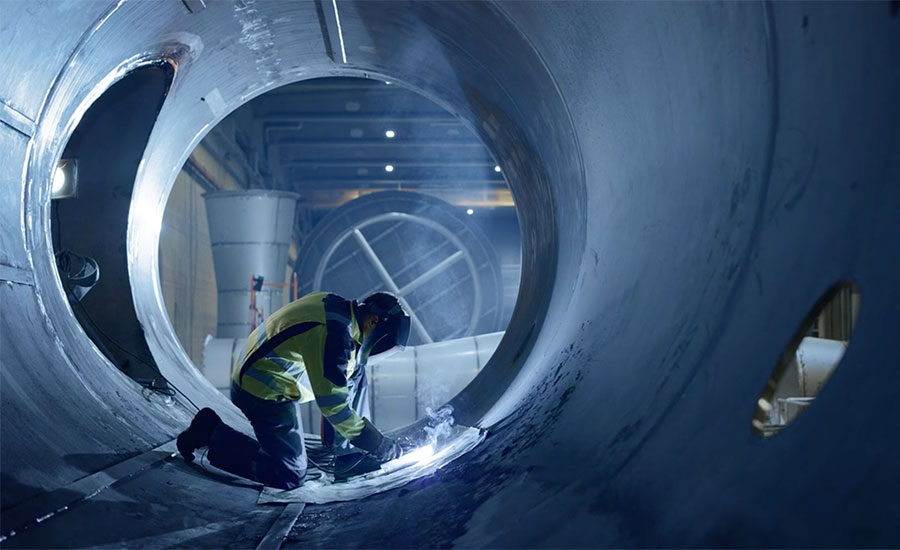What you need to know about welding
Welding offers immediate challenges and long-term opportunities for suppliers.




Over its 100-year history, welding has become one of the most essential technical skills in manufacturing and fabrication. The process of using high-temperature, electrical-powered heat to fuse two pieces of metal or synthetic material has been incorporated throughout the industry in an increasingly wide variety of applications that rely on a range of tools and techniques. Illustrating its critical utility in the industry, more than 60% of American welders are employed in manufacturing.
While no other sector relies on the same sheer amount of welding, it remains a key skill for other industries, such as wholesale distribution and construction. Welding may not play the same central role there that it does in product manufacturing, but it offers wholesale suppliers a tremendous range of options that can have a major impact on everything from internal operations to customer experience. For suppliers, the potential applications vary from storage solutions and configuring floor layout to providing field service for customers.
In fact, with recent and ongoing technological advances making welding faster and more efficient, the process offers an opportunity for wholesalers to streamline their operations and counter the rising costs, labor shortage and supply chain disruptions that are currently challenging the industry.
Welding 101
Welding is one of the most dynamic segments of the skilled trades. Because of the diversity of possible applications and the fundamental utility of the process, welding is an important element in shipbuilding, automobile manufacturing and repair, aerospace applications, engineering and infrastructure.
There are more than 30 different welding processes, but the most common are:
-
Metal inert gas (MIG) welding is common in construction, automotive and marine manufacturing and repair. In this process, a thin wire is heated and forms an electric arc with the base material. Heat from the arc is used to join the two pieces together. While gas metal arc welding (GMAW) is fast and easy to learn, it requires the use of gas, such as carbon dioxide, oxygen, argon or helium to protect the weld from external contaminants.
-
Tungsten inert gas (TIG) welding is an advanced technique used on thin, nonferrous material, such as aluminum, copper, lead and nickel. TIG welding produces lightweight, durable, high-quality welds and is commonly found in bicycle and aircraft manufacturing. The process is among the most difficult welding techniques to master, but also one of the most popular. It’s also expensive.
-
Shielded metal arc welding, commonly referred to as stick welding, is an affordable, manual process, and one of the most common welding techniques. Stick welding uses a heated and coated electrode, or “stick,” to fuse materials without shielding gas. While it’s versatile and easy, stick welding tends to produce results that are less durable than those produced by other methods.
-
Flux cored arc welding (FCAW) is similar to the MIG process but, because the hot wire can produce shielding agents on its own, is more versatile and easier to master. Because it can be practiced outdoors, it is extremely popular for construction projects.
Applications
The uses of welding range from repairs and modifications of existing metal products to manufacturing (particularly heavy appliances and automobiles, as well as in the nautical, aeronautical and aerospace industries), construction, infrastructure and engineering.
In addition, and critical to the supply industry, welding plays an important role in supporting the manufacturing and construction industries. Besides employing welding directly in production and building processes, companies in those industries depend on welding professionals to develop, build, maintain and adapt the structures needed for those processes. Modern factories and production lines could not exist without extensive contributions from welding professionals, not only in fabrication but in maintenance, repair and upgrades. Welders play a huge role in building and operating the large-scale structures that support shipbuilding and major construction and engineering projects.
Welding is equally critical to modern PHCP and PVF supply and distribution facilities. Beyond its essential contribution to the construction of warehousing and supply structures, skilled welders can help supply companies keep those structures up to date as wholesalers’ needs change over time. Welding offers solutions for reconfiguring storage space and layout to accommodate more supply, new products and updated processes so suppliers maintain maximum efficiency.
With its range of possible applications, many companies in heavy commercial and industrial sectors have found internal welding teams the most efficient solution for their needs. Others continue to rely on outside experts, which can save the costs associated with training and equipment. The right solution depends on the particular needs of each company.
Training
Many companies with extensive in-house welding can draw entry-level welders from the pool of existing employees and provide introductory safety training and basic hands-on experience under the mentorship of a veteran welder. Depending on the company’s needs and the skills and goals of the individual welder, various specializations are possible. Tests and certifications offered either internally or by third-party trade organizations open pathways for specialization in residential or commercial aspects of the industry. Because of the variety of applications and technologies and the specialized nature of the process, professional testing for welders is among the most technical and rigorous in the skilled trades.
Trade schools and community colleges are also an important pipeline to the trade, with certification and associate’s degree opportunities that can prepare aspiring welders for available positions before employment.
Unfortunately, the high level of skill and training required for manufacturing welding are contributing factors in an acute welding labor shortage. The time needed to train new welders means that it takes longer for employers to fill positions, and the specialized skills of the job significantly narrow the available talent pool. As in many other skilled trades industries, improving technology that makes welding more efficient has the added benefit of making it more accessible: virtual reality in particular is streamlining and simplifying training; lighter materials and better design make the necessary equipment and safety gear more comfortable; and overall efficiency opens opportunities to a wider group of talent.
Safety always
Welding processes are built on a foundation of safety, but gas, electric shock, fire and even explosions are potential risks. It’s important for welders to follow best practices to protect themselves, their equipment and other people nearby.
-
Check the area: Even in designated professional welding zones, conduct a thorough inspection of the area before beginning welding work. Watch out for flammable material or anything that could impede proper ventilation.
-
Dress appropriately: Make sure you’re fully covered, even for a quick job. Normal flame-resistant cotton pants and long-sleeve shirts are suitable in most cases. A heavy flame-retardant welding jacket adds another layer of protection. Opt for durable leather boots instead of synthetic or canvas shoes.
-
Get the right gear: Investing in a high-quality welding helmet, safety glasses and ergonomic gloves will pay off, sooner or later.
-
Watch for sparks and shocks: Welding arcs can reach temperatures of 5,000 degrees, but the sparks produced are an even greater danger. Remove any flammable materials within 35 feet of the work area before starting. Combining high heat and metal can also create conditions conducive to electric shocks, so stay covered, keep electrodes and other pieces of metal from coming into contact and turn off the power on your equipment before leaving the area.
Invest in the right solution
The complexity of welding as a skilled trade — the extensive ongoing specialized training required, the variety of possible applications and accelerating technological advancements — presents both challenges and opportunities for the supply industry. Internal welding personnel and equipment require a continuing investment, but the increased efficiency and elevated production made possible by an in-house welding team creates the possibility of long-term rewards such as reduced costs and enhanced customer experience. In addition, the option of providing field welding service opens new revenue opportunities and introduces additional ways to meet the needs of customers.
While full internal welding operations are not the right solution for every supplier, such an investment can deliver substantial benefits for many companies that currently either outsource welding services or employ less efficient processes to meet their needs and the expectations of customers.
Looking for a reprint of this article?
From high-res PDFs to custom plaques, order your copy today!







